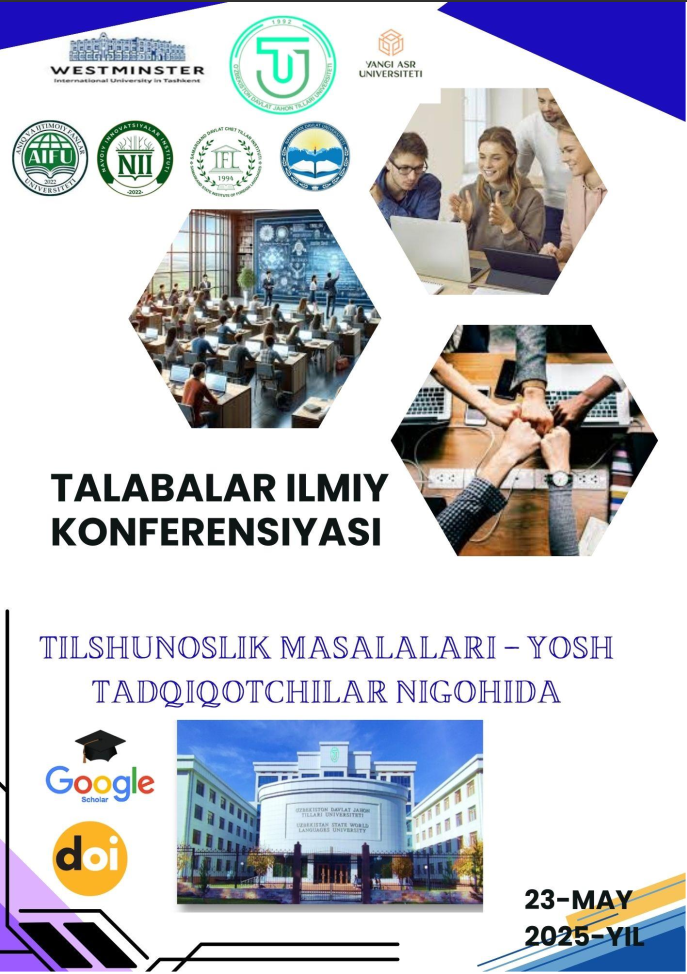THE ROLE OF STYLISTIC DEVICES IN THE COMPOSITION OF CONCEPTUAL INTEGRITY IN FRANCES HODGSON BURNETT’S “THE SECRET GARDEN”
https://doi.org/10.5281/zenodo.15517406
Kalit so‘zlar
Stylistic devices, conceptual integrity, literary analysis, Frances Hodgson Burnett, The Secret Garden, symbolism, metaphor, imagery, character development, narrative cohesion, children's literature, literary stylistics, thematic unity, language and meaning.Annotasiya
This paper investigates the role of stylistic devices in the construction of conceptual integrity within Frances Hodgson Burnett’s The Secret Garden. It explores how literary tools such as metaphor, symbolism, repetition, contrast, and imagery contribute not merely to the aesthetic value of the text but to its deeper thematic cohesion. Through a stylistic approach rooted in literary linguistics, the study identifies specific language features that reinforce the novel’s central themes of healing, transformation, and the restorative power of nature. Drawing on theoretical frameworks proposed by scholars such as Roman Jakobson, M.A.K. Halliday, and Geoffrey Leech, the paper conducts a qualitative analysis of key passages to reveal the linguistic patterns that sustain narrative unity. The findings demonstrate that Burnett’s deliberate stylistic choices are essential for maintaining the internal consistency of the narrative, allowing readers to experience the text as a coherent, emotionally resonant whole. This research highlights the significance of stylistic analysis in uncovering the complex relationship between language form and literary meaning, offering insights into how authors construct powerful and enduring literary works through conscious language design.
Foydalanilgan adabiyotlar ro‘yhati
Burnett, F. H. The Secret Garden. London: Frederick Warne & Co., 1911. p375
Halliday, M. A. K., and Hasan, R. Cohesion in English. London: Longman, 1976. p374.
Jakobson, R. Closing Statement: Linguistics and Poetics. In Style in Language. Cambridge, MA: MIT Press, 1960. p27
Leech, G., and Short, M. Style in Fiction (2nd ed.). London: Pearson Longman, 2007. p464
Kupaysinovna, S. G. (2019). Innovative teaching methods in the preparation of future elementary school teachers. Наука и образование сегодня, (6-2 (41)), 107-108.
Qizi, A. D. K. (2021). TEACHING ENGLISH THROUGH ENGLISH: PROFICIENCY, PEDAGOGY AND PERFORMANCE. Вестник науки и образования, (8-2 (111)), 48-51.
Zakhitovna, M. P. (2023). THE IMPORTANCE OF PRINCIPLES IN TEACHING ENGLISH TO DIFFERENT AGE GROUPS. European International Journal of Pedagogics, 3(06), 85-87.
Alimdjanovna, K. M. (2023). DEVELOPMENT OF STUDENTS'CRITICAL THINKING SKILLS IN ENGLISH CLASSES. European International Journal of Multidisciplinary Research and Management Studies, 3(05), 125-127.
Abulkasimovna, E. Z., & Leonidovna, M. N. (2023, March). THE LEXICAL-SEMANTICAL USAGE OF PROFESSIONAL LEXEMES IN “UTGAN KUNLAR”(" PAST DAYS") BY ABDULLA QADIRI. In International Scientific and Current Research Conferences (pp. 20-22).
SULTONOVA, M. (2024). On the issue of critical thinking.
Gulomova, R. (2017). The importance of fairy tales in teaching English as a second language. Архивариус, 1(2 (17)), 27-29.

